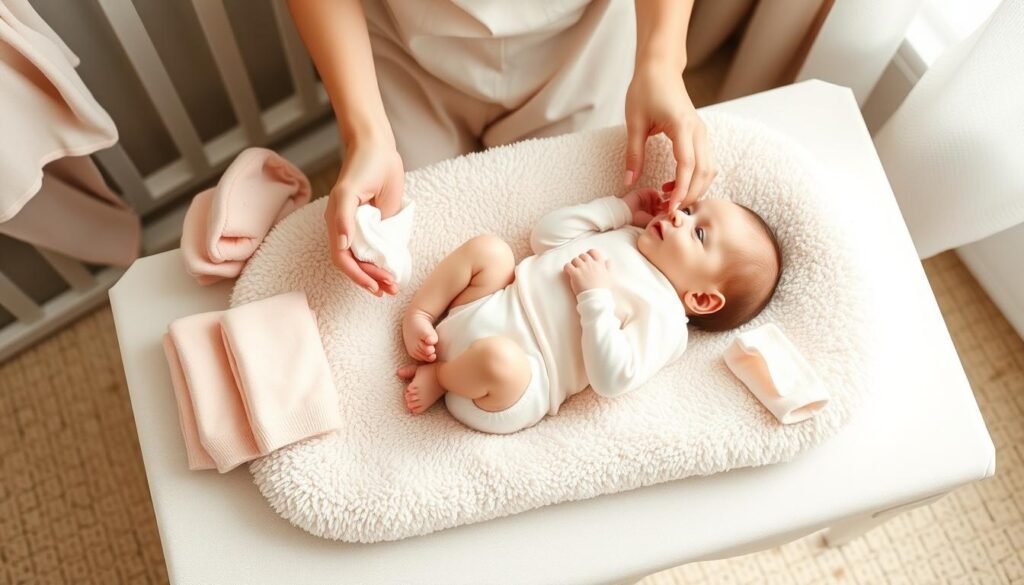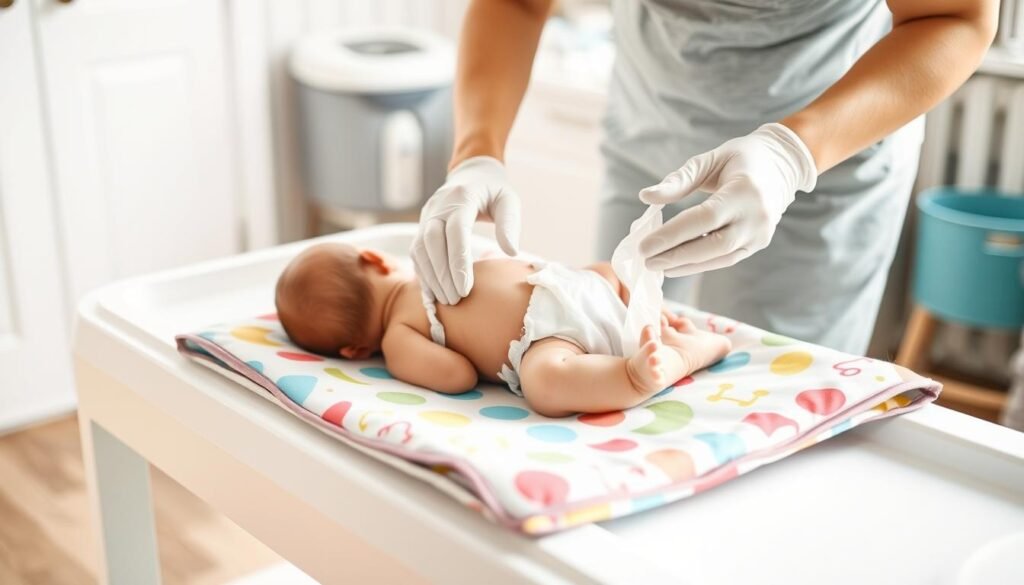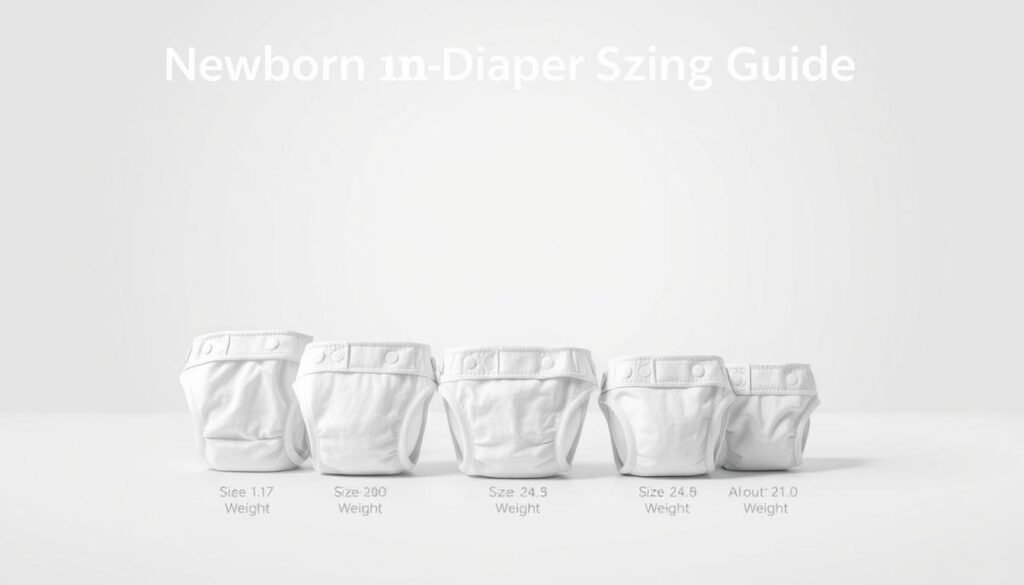
Introduction:
Newborn diapering sometimes causes first-time parents great overwhelm. Typical questions are “Is my baby’s diaper wet again?” The foundation for your baby’s comfort and health is knowledge of which.
This reference will clarify diaper changes for you. You will pick up evening advice and regular diaper changing techniques. Usually every two to three hours, newborns require a dipper change.
Your baby’s health depends on regular diaper changes. They deter skin irritation and diaper rash. This guide will walk you through efficiently changing diapers and monitoring your baby’s condition.
Important Lessons:
- Newborns need diaper changes every 2-3 hours
- Frequent changes help prevent diaper rash and skin irritation
- Watch for signs of wetness and soiling
- Nighttime diapering requires special considerations
- Choose the right diaper size and type for your baby
- Always keep diapering essentials within reach
- Monitor your baby’s diaper output for health indicators
Understanding Newborn Diaper Basics
Learning about diaper changes is key for caring for a newborn. It keeps your baby comfy, healthy, and happy.
Changing diapers is vital for your baby’s skin health. It stops irritations. Newborns need special care with their diapers.
Why Frequent Diaper Changes Matter
Changing diapers often is important for many reasons:
- It stops diaper rash and skin irritation
- It lowers the chance of bacteria growing
- It keeps your baby comfy and clean
- It lets you check on your baby’s health
Normal Diaper Output for Newborns
Knowing your newborn’s diaper habits is important. Newborns usually have 1 to 10 bowel movements a day. This can change based on how they eat:
- Breastfed babies might poop with each feed
- Some might not poop for up to 3 days
- Newborns pee every 1 to 3 hours
Signs Your Baby Needs a Change
Knowing when to change a diaper is important. Look for these signs:
- A wet or dirty diaper
- A strong smell
- Your baby looks uncomfortable
- The diaper feels full or saggy
- Redness or irritation on your baby’s skin
Experts say to change diapers every two to three hours. Or right after they poop. This helps avoid diaper rash and keeps the skin healthy.
Creating an Effective Diaper Change Schedule
It’s important to have a regular diaper change routine for your baby. Knowing when to change diapers helps parents feel more confident in the early days.
Newborns need a lot of diaper changes. In the first few weeks, you’ll need to change diapers 8-12 times a day. This keeps your baby clean, dry, and happy.
Daytime Change Frequency
For daytime, check diapers every 2-3 hours. Change them right away if they’re soiled or wet. Also, watch for at least 5-6 wet diapers in 24 hours.
Pre and Post-Feeding Changes
Timing diaper changes with feedings can make your routine easier. Here’s how:
- Change diapers before feeding to keep them comfortable.
- Change them after feeding to catch any accidents.
- Change diapers during night feedings to avoid waking up.
Monitoring Wet and Soiled Diapers
| Diaper Status | Action Required | Frequency |
|---|---|---|
| Slightly Damp | Monitor | Every 2-3 hours |
| Soaked | Immediate Change | As needed |
| Soiled | Immediate Change | Promptly |
Every baby is different. Watch your baby’s needs and adjust your diaper changing schedule as needed.
Mastering Nighttime Diaper Changes
Changing diapers at night can be tough for new parents. Knowing how to do it right helps your baby sleep well. It also helps you get some rest too.
Experts say not to wake your baby for diaper changes at night. Disposable diapers can handle wetness for hours. This lets your baby sleep without being disturbed. The trick is to pick the right diaper for nighttime.
- Use ultra-absorbent nighttime diapers
- Change diapers right before bedtime
- Apply diaper cream for extra protection
- Use dim red lighting during changes to minimize sleep disruption
Here’s what to do if you need to change a diaper at night:
- Be quick and gentle
- Keep movements minimal
- Use soft, quiet materials
- Avoid full room lighting
Pro tip: Always change soiled diapers immediately, regardless of the time of night. Wet diapers can typically wait until morning if your baby seems comfortable.
Today’s diapers are made to handle lots of wetness. This means you don’t have to change them as often at night. By using smart diapering tips, you can keep your baby dry and comfortable. This helps them sleep well.
Essential Steps for Clean Diaper Changes
Diaper changes are very important for baby hygiene. They help prevent discomfort and skin irritations. Knowing the right steps makes this task easier for everyone.

Proper Cleaning Techniques
Keeping baby clean during diaper changes is key. Here are some important steps:
- Always wipe from front to back to prevent urinary tract infections
- Use gentle, fragrance-free wipes designed for sensitive newborn skin
- Clean thoroughly but gently to avoid skin irritation
- Pat skin dry instead of rubbing to minimize friction
Positioning and Safety Measures
Proper positioning is vital for safe diaper changes. Always hold one hand on the baby to prevent falls. Use a changing pad with safety straps and have all supplies ready before you start.
Preventing Leaks and Diaper Rash
To prevent diaper rash, use barrier cream during each change. Newborns need diaper changes every 2-3 hours. They use about 10-12 diapers a day.
- Check diaper wetness regularly
- Allow skin to air dry when possible
- Use breathable diapers
- Change immediately after bowel movements
Tip: Keep diaper changing supplies organized and easily accessible to make the process smoother and more efficient.
Setting Up Your Diaper Changing Station
Creating a good diaper changing station is key for baby care. It makes changing diapers easier and more comfy for you and your baby. With some planning, you can make this task quick and easy.
A good diaper changing area needs the right supplies, safety, and ease. Parents should make a space that has everything needed for diaper changes. It should also keep the baby safe.
Must-Have Supplies
Your diaper changing station needs some important items for easy changes:
- 1 pack of current-size diapers
- 2 packs of wipes
- 1 tube of diaper cream
- 2 spare pajamas or onesies
- Diaper pail for odor control
- Changing pad with safety straps
Organization Tips
Being organized makes diaper changes easier. Here are some tips:
- Create changing stations on multiple home levels
- Keep half of a dresser drawer for diaper supplies
- Use a second smaller changing station in busy areas
- Arrange supplies within arm’s reach
Safety Considerations
Safety is very important when setting up a diaper changing area. Always keep one hand on the baby during changes. Store cleaning supplies where they can’t be reached. Choose a changing spot away from dangers like window cords or heat sources.
By following these tips, parents can make a safe, organized, and efficient space. This makes caring for the baby easier and less stressful during diaper changes.
Choosing the Right Diaper Size and Type

Choosing the best diapers for your newborn is very important. Knowing the right diaper size stops leaks and keeps your baby comfy. Pampers found that babies use up to 10 diapers a day. So, picking the right size is key.
Click here to find the best newborn diapers.
Diaper sizes are based on weight. This helps parents find the perfect fit:
- Preemie Size: Up to 6 pounds
- Newborn Size: Up to 10 pounds
- Size 1: 8-14 pounds
- Size 2: 12-18 pounds
- Size 3: 16-28 pounds
Look for signs to know when to change diaper sizes:
- Red marks on baby’s skin
- Difficulty fastening diaper tabs
- Frequent leaks
- Diaper rise sitting below the belly button
When picking between disposable and cloth diapers, think about convenience, cost, and the environment. Disposable diapers are easy to use. Cloth diapers are better for the planet. Many choose both for the best of both worlds.
For nighttime, special diapers can help a lot. These diapers soak up more to keep your baby dry. This means less waking up for diaper changes and better sleep for everyone.
Travel and On-the-Go Diapering Essentials
Going out with a newborn needs careful planning. You must pack the right things for your travel diaper bag. This helps you handle surprises on trips.
- 10-12 diapers (1 diaper for every 2-3 hours of travel)
- Diaper rash cream
- Portable changing pad
- Wet wipes
- Waterproof disposal bags
- Extra clothing changes
- Hand sanitizer
Travel tips say to be ready for different situations. For road trips, stop every two hours to change diapers and let your baby move. When flying, change diapers before boarding. Bring noise-reducing earmuffs for comfort in the air.
Smart travelers also pack extra things. Like a small toy, a lightweight blanket, and more clothes. About 70% of parents like diaper bags with lots of pockets and insulated bottle spots. This makes packing easier.
Being ready is important. With the right travel diaper bag and essentials, you can enjoy any trip with your newborn.
🔽 Find Essential Newborn Below! 🔽
👉 Shop Now 👈
Conclusion
Managing diapers is key for your baby’s health and happiness. Parents change 5,000 to 7,000 diapers before potty training. A good diaper guide helps parents face challenges and keep babies well.
Knowing about diapers helps your baby’s skin and comfort. Diaper rash affects 1 in 4 parents. To avoid it, check wetness, pick gentle diapers, and change diapers often.
Brands like Pampers Baby Dry Diapers protect sensitive skin well.
Your care for your baby should be both smart and caring. Most parents use disposable diapers, but cloth diapers can save money. Keeping your baby clean and choosing the right diapers keeps them happy and healthy.
Every diaper change is a chance to check on your baby, bond, and care for them. Stay informed, patient, and proactive in diapering.
FAQ
How many diapers does a newborn typically use per day?
Newborns use 8-12 diapers a day. They need changes often because their bladders are small. In the first weeks, expect 6-8 wet diapers and 3-4 soiled ones.
When should I change my newborn’s diaper?
Change diapers right after bowel movements. Do it every 2-3 hours during the day. Always check before or after feedings to keep your baby comfy.
How do I prevent diaper rash?
To avoid diaper rash, change diapers often. Clean the area gently but well. Let your baby have some air time. Use a protective cream to keep moisture out.
What’s the best way to handle nighttime diaper changes?
Use extra-absorbent diapers at night. Change diapers just before bed. Only change again if it’s soiled or your baby is uncomfortable. Use dim red lights to help them sleep.
How do I know when to switch to a larger diaper size?
Watch for signs like red marks on legs or if the diaper is too tight. Look for leaks or if it’s hard to fasten. Most babies need a bigger size every 2-3 months.
What should I pack in my diaper bag for outings?
Pack diapers, wipes, a changing pad, and diaper cream. Don’t forget plastic bags for soiled items, extra clothes, hand sanitizer, and a small mat for public restrooms.
Disposable or cloth diapers – which is better?
Disposable diapers are easy to use and travel-friendly. Cloth diapers are better for the environment and can save money. Think about your lifestyle and what you prefer.
How can I make diaper changes easier?
Set up a changing station with everything you need close. Use a changing pad with safety straps. Be calm and gentle. Keep distractions like soft toys handy for wiggly babies.

1 thought on “Newborn Diaper Guide: How Often to Change, Nighttime Tips, Essentials to Pack, and Best Diapers”